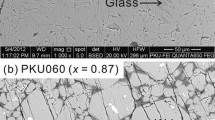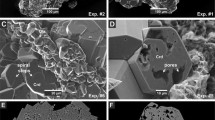Abstract
Differences in equilibration rates among crystals of different sizes may be used to deduce paleofluid changes over time if the crystal-growth mechanism is known. To explore isotopic equilibration rates as a function of illite growth, we studied B-isotope changes during illitization of smectite. Montmorillonite (<2.0 µm SWy-1, K saturated) was reacted with aqueous boric acid (1000 ppm B) at 300°C, 100 MPa in sealed Au capsules (1:1 fluid:mineral ratio). The initial fluid was 0‰ (NBS 951 standard) but after R1 ordering occurred (65 days of reaction) the fluid was changed to −7‰ in order to examine the rate of isotopic re-equilibration. Samples were taken intermittently throughout the experiment. Each aliquot was NH4 exchanged and size separated into fine (<0.2 µm), medium (0.2–2.0 µm) and coarse (>2.0 µm) fractions. The isotopic composition of B in the tetrahedral sheet was then measured for comparison with the predicted equilibrium values.
The fine fraction showed equilibrium isotope ratios within 10 days, indicating that small, newly nucleated crystals precipitate in equilibrium with the fluid under supersaturated, closed conditions. These fine-fraction minerals did not re-equilibrate when the fluid was changed. The medium fraction gradually equilibrated with the initial fluid as illite grew to values >50%, but did not re-equilibrate with the later fluid. The coarse fraction was slow to begin recrystallization, perhaps due to dissolution kinetics of large crystals or the presence of detrital contaminants. However, it showed the fastest rate of isotopic change with crystal growth after R1 ordering. We conclude that at 300°C, the initial B–O bonds formed in illite are stable, and isotopic re-equilibration only occurs on new crystal growth. Therefore, different isotope ratios are preserved in different crystal size fractions due to different rates of crystal growth. Large crystals may reflect equilibrium with recent fluid while smaller crystals may retain isotope compositions reflecting equilibrium with earlier fluids.
Similar content being viewed by others
References
Bove, D.J., Eberl, D.D., McCarty, D.K. and Meeker, G.P. (2002) Characterization and modeling of illite crystal particles and growth mechanisms in a zoned hydrothermal deposit, Lake City, Colorado. American Mineralogist, 87, 1546–1556.
Brime, C. and Eberl, D.D. (2002) Growth mechanisms of low-grade illites based on shapes of crystal thickness distributions. Swiss Bulletin of Mineralogy and Petrology, 82, 203–209.
Clauer, N., Środoń, J, Franců, J. and Šuchá, V. (1997) K-Ar dating of illite fundamental particles separated from illite-smectite. Clay Minerals, 32, 181–196.
Clauer, N., Rinckenback, T., Weber, F., Sommer, F., Chaudhuri, S. and O’Neil, J.R. (1999) Diagenetic evolution of clay minerals in oil-bearing Neogene sandstones and associated shales from Mahakam Delta Basin (Kalimantan, Indonesia). American Association of Petroleum Geologists Bulletin, 83, 62–87.
Clauer, N., Liewig, N., Pierret, M.-C. and Toulkeridis, T. (2003) Crystallization conditions of fundamental particles from mixed-layer illite-smectite of bentonites based on isotopic data (K-Ar, Rb-Sr and δ18O). Clays and Clay Minerals, 51, 664–674.
Drits, V.A., Sakharov, B.A., Dainyak, L.G., Salyn, A.L. and Lindgreen, H. (2002) Structural and chemical heterogeneity of illite-smectites from Upper Jurassic mudstones of east Greenland related to volcanic and weathered parent rocks. American Mineralogist, 87, 1590–1607.
Eberl, D.D., Whitney, G. and Khoury, H. (1978) Hydrothermal reactivity of smectite. American Mineralogist, 63, 401–409.
Eberl, D.D., Drits, V.A., Środoń, J. and Nüesch, R. (1996) MUDMASTER: a program for calculating crystallite size distributions and strain from the shapes of X-ray diffraction peaks. US Geological Survey Open File Report 96–171.
Eberl, D.D., Drits, V.A. and Środoń, J. (1998a) Deducing the growth mechanisms of minerals from the shapes of crystal size distributions. American Journal of Science, 298, 499–533.
Eberl, D.D., Nüesch, Šuchá, V. and Tsipursky, S. (1998b) Measurement of fundamental illite particle thicknesses by X-ray diffraction using PVP-10 intercalation. Clays and Clay Minerals, 46, 89–97.
Eberl., D.D., Drits, V.A. and Środoń, J. (2000) User’s guide to GALOPER — a program for simulating the shapes of crystal size distributions. US Geological Survey Open File Report 00–505.
Eberl, D.D., Kile, D.E. and Drits, V.A. (2002) On geological interpretations of crystal size distributions: constant versus proportionate growth. American Mineralogist, 87, 1235–1241.
Elliott, W.C., Aronson, J.L., Matisoff, G. and Gautier, D.L. (1991) Kinetics of the smectite to illite transformation in the Denver Basin: Clay mineral, K-Ar data and mathematical model results. American Association of Petroleum Geologists Bulletin, 75, 436–462.
Girard, J-P. and Savin, S.M. (1996) Intracrystalline fractionation of oxygen isotopes between hydroxyl and non-hydroxyl sites in kaolinite measured by thermal dehydroxylation and partial fluorination. Geochimica et Cosmochimica Acta, 60, 469–487.
Güven, N. and Huang, W.-L. (1991) Effects of octahedral Mg2+ and Fe3+ substitutions on hydrothermal illitization reactions. Clays and Clay Minerals, 39, 387–399.
Hemming, N.G. and Hanson, G.N. (1992) Boron isotopic composition and concentration in modern marine carbonates. Geochimica et Cosmochimica Acta, 56, 537–543.
Hervig, R.L. (1996) Analyses of geological materials for boron by secondary ion mass spectrometry. Pp. 789–803 in: Boron Mineralogy, Petrology and Geochemistry (E.S. Grew and L.M. Anovitz, editors). Reviews in Mineralogy, 33, Mineralogical Society of America, Washington, D.C.
Hervig, R.L., Moore, G.M., Williams, L.B., Peacock, S.M., Holloway, J.R. and Roggensack, K.R. (2002) Isotopic and elemental partitioning of boron between hydrous fluid and silicate melt. American Mineralogist, 87, 769–774.
Hingston, F.J. (1964) Reactions between boron and clays. Australian Journal of Soil Research, 2, 83–95.
Kapteyn, J.C. (1903) Skew Frequency Curves in Biology and Statistics. Noordhoff Astronomical Laboratory, Groningen, The Netherlands, 69 pp.
Kile, D. and Eberl, D.D. (2003) On the origin of size-dependent and size-independent crystal growth: Influence of advection and diffusion. American Mineralogist, 88, 1514–1521.
Long, J.V.P. (1995) Microanalysis from 1950 to the 1990s. Pp. 1–48 in: Microprobe Techniques in the Earth Sciences (P.J. Potts, J.F.W. Bowles, S.J.B. Reed and M.R. Cave, editors). Chapman & Hall, London.
Marumo, K., Longstaffe, F.J. and Matsubaya, O. (1995) Stable isotope geochemistry of clay minerals from fossil and active hydrothermal systems, southwestern Hokkaido, Japan. Geochimica et Cosmochimica Acta, 59, 2545–2559.
Moore, D.M. and Reynolds, R.C. (1997) X-ray Diffraction and the Identification and Analysis of Clay Minerals, 2nd edition. Oxford University Press, New York, 378 pp.
Mystkowski, K., Środoń, J. and Elsass, F. (2000) Mean thickness and thickness distribution of smectite crystallites. Clay Minerals, 35, 545–557.
Palmer, M.R. and Swihart, G.H. (1996) Boron isotope geochemistry: an overview. Pp. 709–744 in: Boron Mineralogy, Petrology and Geochemistry (E.S. Grew and L.M. Anovitz, editors). Reviews in Mineralogy 33, Mineralogical Society of America, Washington, D.C.
Pevear, D.R. (1992) Illite age analysis, a new tool for basin thermal analysis. Pp. 1251–1254 in: Water-Rock Interaction (Y.K. Kharaka and A.S. Maest, editors). Balkema, Rotterdam, The Netherlands.
Roberson, H.E. and Lahann, R.W. (1981) Smectite to illite conversion rates; Effects of solution chemistry. Clays and Clay Minerals, 29, 129–135.
Savin, S.M. and Lee, M. (1988) Isotopic studies of phyllosilicates. Pp. 189–223 in: Hydrous Phyllosilicates (Exclusive of Micas) (S.W. Bailey, editor). Reviews in Mineralogy, 19, Mineralogical Society of America, Washington, D.C.
Sheppard, S.M.F. and Gilg, H.A. (1996) The stable isotope geochemistry of clay minerals. Clay Minerals, 31, 1–24.
Środoń, J. and Clauer, N. (2001) Diagenetic history of Lower Palaeozoic sediments in Pomerania (northern Poland), traced across the Teisseyre-Tornquist tectonic zone using mixed-layer illite/smectite. Clay Minerals, 36, 15–27.
Środoń, J., Eberl, D.D. and Drits, V.A. (2000) Evolution of fundamental particle size during illitization of smectite and implications for reaction mechanism. Clays and Clay Minerals, 48, 446–458.
Tonarini, S., Pennisi, M. and Leeman, W.P. (1997) Precise boron isotopic analysis of complex silicate (rock) samples using alkali carbonate fusion and ion-exchange separation. Chemical Geology, 142, 129–137.
Whitney, G. and Northrup, H.R. (1988) Experimental investigation of the smectite to illite reaction: Dual reaction mechanisms and oxygen-isotope systematics. American Mineralogist, 73, 77–90.
Williams, L.B. (2000) Boron isotope geochemistry during burial diagenesis. PhD thesis, University of Calgary, Alberta, Canada, 168 pp.
Williams, L.B. and Hervig, R.L. (2002) Intracrystalline boron isotope variations in clay minerals: a potential low-temperature single mineral geothermometer. American Mineralogist, 87, 1564–1570.
Williams, L.B. and Hervig, R.L (2005) Lithium and boron isotopes in illite-smectite: The importance of crystal size. Geochimica et Cosmochimica Acta, 69, 5705–5716.
Williams, L.B., Hervig, R.L., Holloway, J.R. and Hutcheon, I. (2001) Boron isotope geochemistry during diagenesis: Part 1. Experimental determination of fractionation during illitization of smectite. Geochimica et Cosmochimica Acta, 65, 1769–1782.
Zhang, L., Chan, L.H. and Gieskes, J.M. (1998) Lithium isotope geochemistry of pore waters from Ocean Drilling Program Sites 918 and 919, Irminger Basin. Geochimica et Cosmochimica Acta, 62, 2437–2450.
Author information
Authors and Affiliations
Corresponding author
Rights and permissions
About this article
Cite this article
Williams, L.B., Hervig, R.L. Crystal-size dependence of illite-smectite isotope equilibration with changing fluids. Clays Clay Miner. 54, 531–540 (2006). https://doi.org/10.1346/CCMN.2006.0540501
Received:
Revised:
Published:
Issue Date:
DOI: https://doi.org/10.1346/CCMN.2006.0540501




